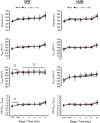On exercise thermoregulation in females: interaction of endogenous and exogenous ovarian hormones
- PMID: 30320879
- PMCID: PMC6312528
- DOI: 10.1113/JP276233
On exercise thermoregulation in females: interaction of endogenous and exogenous ovarian hormones
Abstract
Key points: One in two female athletes chronically take a combined, monophasic oral contraceptive pill (OCP). Previous thermoregulatory investigations proposed that an endogenous rhythm of the menstrual cycle still occurs with OCP usage. Forthcoming large international sporting events will expose female athletes to hot environments differing in their thermal profile, yet few data exist on how trained women will respond from both a thermoregulatory and performance stand-point. In the present study, we have demonstrated that a small endogenous rhythm of the menstrual cycle still affects Tcore and also that chronic OCP use attenuates the sweating response, whereas behavioural thermoregulation is maintained. Furthermore, humid heat affects both performance and thermoregulatory responses to a greater extent than OCP usage and the menstrual cycle does.
Abstract: We studied thermoregulatory responses of ten well-trained ( , 57 ± 7 mL min-1 kg-1 ) women taking a combined, monophasic oral contraceptive pill (OCP) (≥12 months) during exercise in dry and humid heat, across their active OCP cycle. They completed four trials, each of resting and cycling at fixed intensities (125 and 150 W), aiming to assess autonomic regulation, and then a self-paced intensity (30-min work trial) to assess behavioural regulation. Trials were conducted in quasi-follicular (qF) and quasi-luteal (qL) phases in dry (DRY) and humid (HUM) heat matched for wet bulb globe temperature (WBGT) (27°C). During rest and exercise at 125 W, rectal temperature was 0.15°C higher in qL than qF (P = 0.05) independent of environment (P = 0.17). The onset threshold and thermosensitivity of local sweat rate and forearm blood flow relative to mean body temperature was unaffected by the OCP cycle (both P > 0.30). Exercise performance did not differ between quasi-phases (qF: 268 ± 31 kJ, qL: 263 ± 26 kJ, P = 0.31) but was 5 ± 7% higher during DRY than during HUM (273 ± 29 kJ, 258 ± 28 kJ; P = 0.03). Compared to matched eumenorrhoeic athletes, chronic OCP use impaired the sweating onset threshold and thermosensitivity (both P < 0.01). In well-trained, OCP-using women exercising in the heat: (i) a performance-thermoregulatory trade-off occurred that required behavioural adjustment; (ii) humidity impaired performance as a result of reduced evaporative power despite matched WBGT; and (iii) the sudomotor but not behavioural thermoregulatory responses were impaired compared to matched eumenorrhoeic athletes.
Keywords: Exercise physiology; Oral Contraception; Thermoregulation.
© 2018 The Authors. The Journal of Physiology © 2018 The Physiological Society.
Figures






Similar articles
-
Influence of menstrual phase and arid vs. humid heat stress on autonomic and behavioural thermoregulation during exercise in trained but unacclimated women.J Physiol. 2017 May 1;595(9):2823-2837. doi: 10.1113/JP273176. Epub 2017 Jan 4. J Physiol. 2017. PMID: 27900769 Free PMC article.
-
Menstrual cycle phase does not modulate whole body heat loss during exercise in hot, dry conditions.J Appl Physiol (1985). 2019 Feb 1;126(2):286-293. doi: 10.1152/japplphysiol.00735.2018. Epub 2018 Nov 29. J Appl Physiol (1985). 2019. PMID: 30496713 Free PMC article.
-
Exercise performance over the menstrual cycle in temperate and hot, humid conditions.Med Sci Sports Exerc. 2012 Nov;44(11):2190-8. doi: 10.1249/MSS.0b013e3182656f13. Med Sci Sports Exerc. 2012. PMID: 22776870
-
Effects of thermal stress during rest and exercise in the paediatric population.Sports Med. 1998 Apr;25(4):221-40. doi: 10.2165/00007256-199825040-00002. Sports Med. 1998. PMID: 9587181 Review.
-
The Effects of Oral Contraceptives on Exercise Performance in Women: A Systematic Review and Meta-analysis.Sports Med. 2020 Oct;50(10):1785-1812. doi: 10.1007/s40279-020-01317-5. Sports Med. 2020. PMID: 32666247 Free PMC article.
Cited by
-
Effect of Pre-Exercise Caffeine Intake on Endurance Performance and Core Temperature Regulation During Exercise in the Heat: A Systematic Review with Meta-Analysis.Sports Med. 2022 Oct;52(10):2431-2445. doi: 10.1007/s40279-022-01692-1. Epub 2022 May 26. Sports Med. 2022. PMID: 35616851
-
Do E2 and P4 contribute to the explained variance in core temperature response for trained women during exertional heat stress when metabolic rates are very high?Eur J Appl Physiol. 2022 Oct;122(10):2201-2212. doi: 10.1007/s00421-022-04996-2. Epub 2022 Jul 7. Eur J Appl Physiol. 2022. PMID: 35796828 Free PMC article.
-
Thermoregulatory and perceptual responses of lean and obese fit and unfit girls exercising in the heat.J Pediatr (Rio J). 2020 Jul-Aug;96(4):464-471. doi: 10.1016/j.jped.2018.12.011. Epub 2019 Apr 18. J Pediatr (Rio J). 2020. PMID: 31005547 Free PMC article.
-
Proposed framework for forecasting heat-effects on motor-cognitive performance in the Summer Olympics.Temperature (Austin). 2021 Aug 20;8(3):262-283. doi: 10.1080/23328940.2021.1957367. eCollection 2021. Temperature (Austin). 2021. PMID: 34485620 Free PMC article.
-
Female Sex Hormone Effects on the Vasculature: Considering the Validity of Restricting Study Inclusion to Low-Hormone Phases.Front Physiol. 2020 Oct 27;11:596507. doi: 10.3389/fphys.2020.596507. eCollection 2020. Front Physiol. 2020. PMID: 33192613 Free PMC article.
References
-
- Belding HS & Hatch TF (1955). Index for evaluating heat stress in terms of resulting physiological strain. Heat Piping Air Cond 27, 129–136.
-
- Brengelmann GL, Savage MV & Avery DH (1994). Reproducibility of core temperature threshold for sweating onset in humans. J Appl Physiol 77, 1671–1677. - PubMed
-
- Brotherhood JR (2008). Heat stress and strain in exercise and sport. J Sci Med Sport 11, 6–19. - PubMed
-
- Budd GM (2008). Wet‐bulb globe temperature (WBGT) – its history and its limitations. J Sci Med Sport 11, 20–32. - PubMed
-
- Chang RT, Lambert GP, Moseley PL, Chapler FK & Gisolfi CV (1998). Effect of estrogen supplementation on exercise thermoregulation in premenopausal women. J Appl Physiol 85, 2082–2088. - PubMed
MeSH terms
Substances
LinkOut - more resources
Full Text Sources
Medical
Miscellaneous

